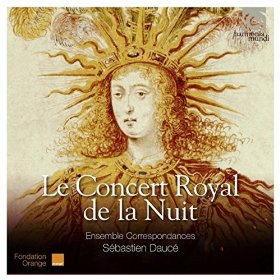Le Concert Royal de la Nuit
View record and artist detailsRecord and Artist Details
Genre:
Vocal
Label: Harmonia Mundi
Magazine Review Date: 11/2015
Media Format: CD or Download
Media Runtime: 153
Mastering:
DDD
Catalogue Number: HMC95 2223/4

Author: David Vickers
Sébastien Daucé has designed a selective exposition of the musical dimension of the multifaceted Ballet de la Nuit. Vocal music by Jean de Cambefort includes a spellbinding solo for Night that begins the first veille (the alto soloist Lucile Richardot is accompanied sensuously by a consort of viols) and a hushed dialogue for Sleep and Silence that commences the fourth veille (sung delicately by bass Etienne Bazola and soprano Caroline Bardot). Ensemble Correspondances play about two-thirds of the original 1653 dances, reconstructed expertly by Daucé from a manuscript first violin part copied nearly 40 years after the production. It is likely some instrumental music was written by members of the illustrious Vingt-quatre Violons du Roi, although one wonders if any anonymous bits might be the handiwork of the 20-year-old Lully (who danced five roles in the Ballet de la Nuit). His future father-in-law Michel Lambert is the composer of a dialogue sung sweetly by three uncredited Graces.
Daucé invokes the privilege of creative licence with the interpolation of numerous extracts from operas by Italians invited to Paris by Cardinal Mazarin during the early years of the Sun King’s reign. The bulk of the third veille is compiled from Cavalli’s Ercole amante (1662) and the fourth veille draws from Rossi’s Orfeo (1647), including a beguiling Passacaille that seamlessly follows on from two lyrical airs by Antoine Boësset. A rotating team of up to 52 musicians traverse the musical spectrum from whispered intimacy to jovial ceremony. My only quibble is that the diverse authorship of the music could have been cited more helpfully in Harmonia Mundi’s libretto instead of the reader having to jump back and forth to abbreviations in the track-listing, but the copiously illustrated hardback book provides plenty of fascinating material to mull over.
Discover the world's largest classical music catalogue with Presto Music.

Gramophone Digital Club
- Digital Edition
- Digital Archive
- Reviews Database
- Full website access
From £8.75 / month
Subscribe
Gramophone Full Club
- Print Edition
- Digital Edition
- Digital Archive
- Reviews Database
- Full website access
From £11.00 / month
Subscribe
If you are a library, university or other organisation that would be interested in an institutional subscription to Gramophone please click here for further information.




